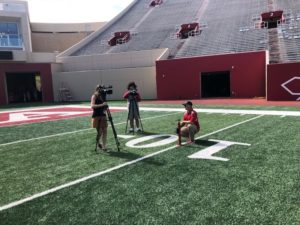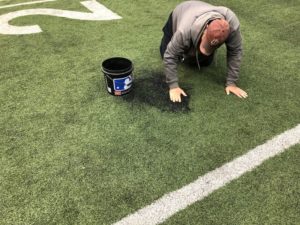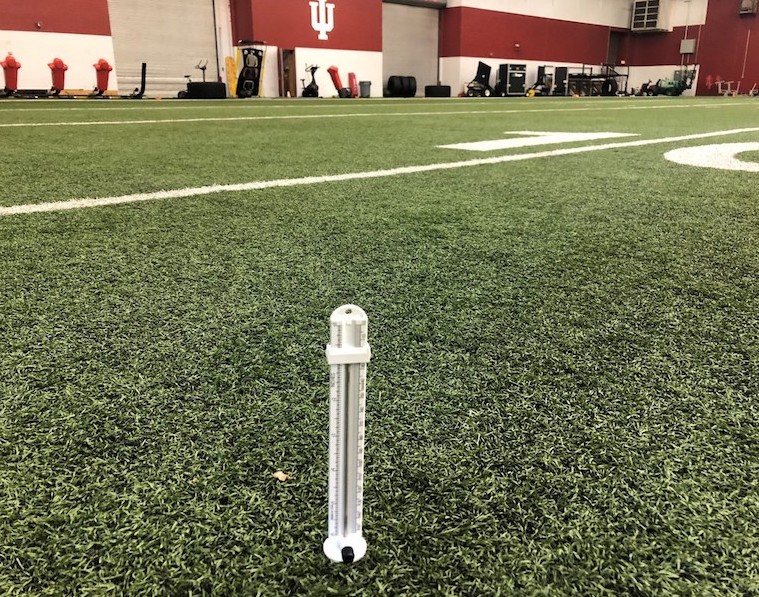By Jeremy Tredway
The word “essential” seems to be thrown around lately when it comes to basic job duties and responsibilities. I’m sure most of you have found yourself in some kind of meeting during the last couple of months trying to justify why certain jobs are essential to your department. If you’re like me, in most cases these essential tasks revolved around mowing and just general cultivation practices for our natural grass surfaces. I’m not sure how many of us felt the need to throw our synthetic turf fields into the mix of these conversations.
I certainly didn’t go down that road. However, as we start to reopen our fields for play, I encourage you to develop a general maintenance plan for your synthetic surfaces if you don’t already have one. I think the core of this plan should be “scouting.” We were all taught in Turf 101 to scout the grass and look for disease, insect damage, and moisture issues – just to name a few. This basic concept will translate to synthetic turf as well; but, instead of looking for the issues just mentioned, you’re looking for things such as displaced crumb rubber (divots in the turf) and temperature issues in the heat of the summer. Surface firmness – or in some cases how “soft” the field is – is something that can be diagnosed by just walking the field on a regular basis.

“Zero maintenance” and “low maintenance” are just a couple of the catchphrases that we often hear mentioned when it comes to synthetic turf maintenance. Most of us just roll our eyes and understand that these terms are misleading and, in most cases, just a flat out lie. Although synthetic turf might not require as much maintenance as a natural grass field, it certainly requires some maintenance in order to ensure that it meets, and sometimes exceeds, the turf’s life expectancy.
As sports field managers, we’re often creatures of habit. We devise a plan of attack on how to approach the maintenance of our fields. Sometimes these plans will be on a daily, weekly or even monthly basis. These schedules are often based on what we perceive to be “normal” working operations. The times that we face now as field managers are anything but “normal.” With reductions in employee work hours and just an overall reduction in our maintenance budgets, many of us have had to throw out our usual work schedules, which has led us down an uncomfortable path of uncertainty. Thinking outside the box has become important as we prioritize what maintenance practices to perform on our fields while juggling all of the issues that the global pandemic has thrown our way.
At Indiana University, we manage approximately 10 acres of synthetic turf fields. We operate with three full-time groundskeepers, and, depending on the time of year, we’ll add an additional three to four part-time workers. During a typical working week, we’ll spend around 20 “man” hours on our 10 acres of turf. The basic maintenance practices that we do during this time include sweeping, dragging or decompacting of the turf. We try to walk the fields at least once a week to get a feel for how they are performing, and also scout any issues that might be popping up with the turf. These issues could range from divots in the turf to a loose seam that might need to be addressed. During the summer months, we also scout for weed encroachment in the turf. Just like a natural grass field, our level of attention to each turf field will be dependent on the amount and level of play on each field.

The start of each season brings on an added level of care and maintenance for each field. For example, during football season, we sweep and drag the field before and after each game.
During the last five to 10 years, surface firmness as it relates to concussions and overall player safety has become a hotbed issue in football. We test the field’s firmness with the Clegg hammer before and after each game. We make sure to keep a log of the test results so we can see how the field is performing throughout the season. I also find myself monitoring how “soft” the field is throughout the season. Without getting into specifics, I’ve found that our fields tend to be spongy at times, and we do our best to mitigate this issue as well. Other examples of in-season maintenance practices we might perform include insert repairs at baseball, as well as irrigation repairs at field hockey. This in-season maintenance work will typically fall within the 20 hours a week that we spend on our synthetic turf. As we move into the summer months and what we call “camp” season, our maintenance program will lean more toward preventative measures along the line of monitoring or scouting the playing surfaces. Since the camp season is usually during the hot summer months, we also do our best to monitor the surface temperature of the fields using a basic infrared heat thermometer.
I often get asked what are some of the most important tools for synthetic turf maintenance. If I had to pick one tool that I wouldn’t want to do without, it would be our infill depth gauge. This gauge retails for around $40, and is pretty invaluable when it comes to scouting and understanding where our fields stand in terms of firmness. We’ve found that infill depth will provide a good idea of how firm or soft the field might be. Instead of sending a couple of employees out to Clegg test each field, I might just have one guy go out and check the infill depths of each field. If we find a field – or, at the very least, an area of a field – having some inconsistent infill depth readings, then we will address that particular area accordingly. We also use a turf sweeper/collector to do most of our vacuuming and decompacting of our fields. We run it over each of our synthetic fields approximately once a month, depending on usage.
One area of concern that’s certainly been brought to the forefront of synthetic turf maintenance during the last few months is disinfecting the turf. For the last three years, we’ve been disinfecting our indoor field on a regular basis. With the concern over COVID-19 and player safety, we’ve now been disinfecting all of our surfaces on a weekly basis. Once athletes return to campus, we will be looking to make these applications on a daily basis. This will make a huge impact on our maintenance staff as we navigate this “new normal.” I’m planning for one full-time employee to spend at least 40 hours a week disinfecting playing surfaces. This will be a significant increase in our man-hours spent on synthetic turf. This will once again throw our “normal” working operations into limbo as we try and find ways to get fields disinfected on a regular basis – all while doing our regular maintenance.
Synthetic turf maintenance isn’t always a number-one priority for sports field managers. It’s very easy for us to move it to the back burner, and, in some cases, take it off the burner all together. This will only become magnified in these unprecedented times. As we all head back to a more normal work schedule, I would encourage you to establish or reevaluate your current synthetic turf maintenance program in order to define what you feel are “essential” turf maintenance practices for your synthetic fields.
Jeremy Tredway is sports turf manager at Indiana University, Bloomington, Ind.


